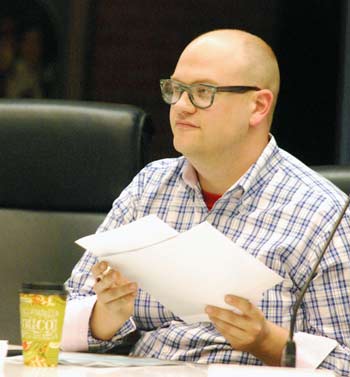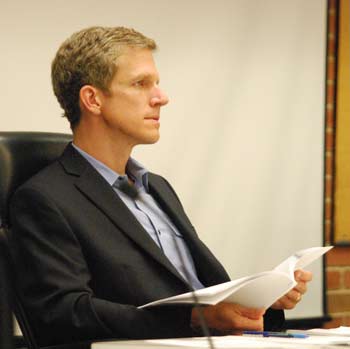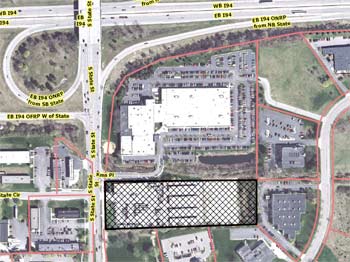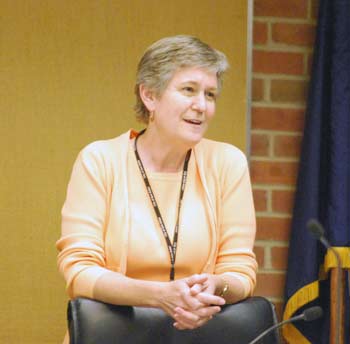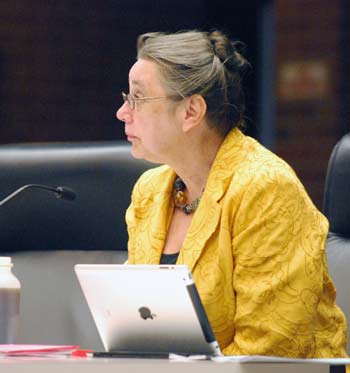Planning Commission OKs Non-Motorized Plan
Ann Arbor planning commission meeting and work session (Sept. 10, 2013): Planning commissioners acted on a change to the city’s master plan, by approving an update to the non-motorized transportation plan.
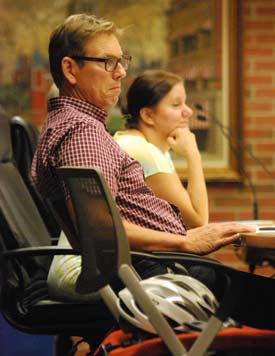
Architect and Ann Arbor planning commissioner Ken Clein shows evidence of his non-motorized transportation – his bicycle helmet. In the background is commissioner Diane Giannola. (Photos by the writer.)
Items in the city’s master plan must receive approval from both the planning commission and the council, so councilmembers will be asked to vote on the update as well. [.pdf of draft 2013 non-motorized transportation plan update]
The 79-page document includes sections on planning and policy, as well as recommendations for short-term and long-term projects, such as bike boulevards, crosswalks, sidewalks and larger efforts like the Allen Creek greenway and Border-to-Border Trail. An additional document – over 100 pages – outlines the update’s public participation process, including emails and comments received during public meetings.
Eli Cooper, the city’s transportation program manager, briefed commissioners on this update, and much of their discussion centered on how to prioritize and implement the items in the plan – especially the funding for sidewalk “gaps.”
Cooper pointed out that implementation relies on including these projects in the city’s capital improvement plan (CIP), which the planning commission reviews and recommends for approval each year. City planning manager Wendy Rampson suggested that the commission could reconvene its CIP committee to talk about these issues.
In its other item of business, commissioners unanimously recommended approval of a proposed expansion to the U-Haul business at 3655 S. State St., south of the I-94 interchange. It will be forwarded to the city council for consideration.
The relatively short meeting – lasting about 90 minutes – was followed by a working session focused on Michigan’s “Redevelopment Ready Communities” program, in which the city of Ann Arbor is participating. [.pdf of program overview]
Rampson described the program as a tool to help communities put in place elements that would allow redevelopment to happen. Those things include master plans that are clear about what community expectations are for new developments, and zoning needs to reflect those expectations in a very specific way. It means that when developers look at a specific property, they’ll be able to know exactly what they can do.
If the city completes the state’s evaluation successfully, Rampson said, then it would be certified as a “Redevelopment Ready” community. This is a relatively new program, but the state has indicated that communities with this certification could receive priority points on grants from the Michigan Economic Development Corp. and the Michigan State Housing Development Authority (MSHDA).
Before the staff can proceed, Rampson explained, the city council must pass a resolution stating that the city can participate. On Oct. 14, the issue will be on the agenda for a joint city council and planning commission working session, although the main topics will be the current downtown zoning review and R4C/R2A zoning revisions.
Commissioners discussed how this program might be received by the community, with Sabra Briere – who also serves on the city council – pointing out that for some people “redevelopment ready” sounds like “tear down all the old stuff.” She noted that development is a very sensitive topic right now.
The issue of development also arose during a brief update from Rampson about the ongoing downtown zoning review. The consultants who are leading this effort – Erin Perdu and Megan Masson-Minock – have put together a workbook that they’ve been presenting at public forums. [.pdf of workbook] The same information is part of an online survey that’s underway through Sept. 17. A final public forum to review all of the feedback gathered so far will be held on Thursday, Sept. 19 starting at 7 p.m. at Workantile, 118 S. Main in downtown Ann Arbor.
The goal is to review the consultants’ recommendations at an Oct. 8 planning commission working session, and then take action on those recommendations at the commission’s Oct. 15 regular meeting. At that point, the recommendations will be transmitted to the council, Rampson said.
Non-Motorized Transportation Update
An update to the city of Ann Arbor’s non-motorized transportation plan, which is part of the city’s master plan, was on the Sept. 10 for approval by the planning commission. The commission was also asked to recommend that the plan be approved by the city council. Items in the city’s master plan must receive approval from both the planning commission and the council. [.pdf of draft 2013 non-motorized transportation plan update]
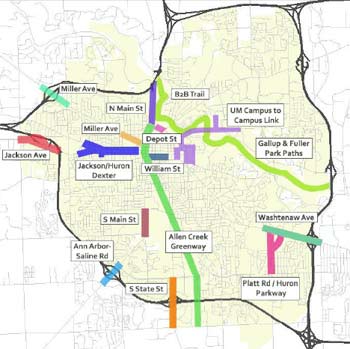
Map identifying geographic areas for improvements for pedestrians and bicyclists, as noted in the 2013 non-motorized transportation plan update.
The update will be an amendment to the main non-motorized transportation plan, which was adopted in 2007. The new document is organized into three sections: (1) planning and policy updates; (2) updates to near-term recommendations; and (3) long-term recommendations.
Examples of planning and policy issues include design guidelines, recommendations for approaches like bike boulevards and bike share programs, and planning practices that cover education campaigns, maintenance, crosswalks and other non-motorized elements for pedestrians and bicyclists.
For example, the update recommends that the city begin developing a planning process for bike boulevards, which are described as “a low-traffic, low-speed road where bicycle interests are prioritized.” Sections of West Washington (from Revena to First), Elmwood (from Platt to Canterbury) and Broadway (from its southern intersection with Plymouth to where it rejoins Plymouth about a mile to the northeast are suggested for potential bike boulevards.
Near-term recommendations include lower-cost efforts like re-striping roads to install bike lanes and adding crossing islands. Longer-term projects that were included in the 2007 plan are re-emphasized: the Allen Creek Greenway, Border-to-Border Trail, Gallup Park & Fuller Road paths, and and a Briarwood-Pittsfield pedestrian bridge.
Eli Cooper, the city’s transportation program manager, was on hand to review the update and answer questions. He noted that the update had been in the works for two years. Even so, that process was still about 18 months faster than when the original plan was adopted, he noted.
It’s important to evaluate individual projects regularly as well as the city’s overall strategy, Cooper said. The update also records the progress of the original plan, identifies challenges and outlines philosophies that have “come into vogue” since the 2007 report, he said.
For example, Cooper noted that funding for a new bicycle sharing program was recently approved by the city council. Such a concept hadn’t even been discussed when the 2007 plan was adopted. “Green” bike lanes is another approach that’s catching on – using painted green pavement to highlight the location of bike lanes.
Cooper also described the public outreach that had been conducted, including focus groups, public forums and surveys. The update document includes about 100 pages that outline the public process, as well as written communications and comments received during public meetings. [.pdf of public process section]
He reported that Ann Arbor’s bicycling community favors pavement markings compared to roadside signs to indicate bike lanes, so the city will be emphasizing that approach in the future.
Cooper also highlighted the plan’s recommendations – both near term and long term – for taking action in certain geographic areas. Locations for nearer-term improvements include Main Street, Jackson Avenue, South State, Washtenaw Avenue, and the University of Michigan campus-to-campus link. Longer term areas include the Allen Creek greenway and Border-to-Border Trail.
The key thing that Cooper said he wanted to share with commissioners is that this is more than just a plan. “We have a great plan, but we’ve been doing it,” he said. The city has gone from having about six miles of bike lanes scattered across the city to now having a network of about 40 miles of bike lanes, he reported.
Residents have told him that they are encouraged by what the city is doing, Cooper concluded, and are encouraging the city to do even more.
Non-Motorized Transportation Update: Commission Discussion
Bonnie Bona wondered how many people participated in the update. Eli Cooper replied that if he discounted the thousands of people who passed by the table that was staffed at the annual green fair for the past two years, there were a couple hundred who attended workshops, and about 90 who attended focus groups. Including survey respondents, Cooper estimated 300-500 people were involved in giving formal input.
Bona asked about the history of getting input for the 2007 plan. Cooper, who joined the city in 2005, said the public participation element of that initial plan was nearly done when he was hired. He deferred the question to planning manager Wendy Rampson. She reported that the 2007 plan had emerged from the previous northeast area transportation plan, and that’s where a lot of ideas about on-road bike lanes had been vetted. In the early 2000s, “there were some pretty lively debates about whether bikes belonged on roads,” Rampson said. That interest carried over into development of the plan adopted in 2007.
Bona also asked Cooper to explain why the city has a non-motorized transportation plan, and not just an integrated transportation plan. She cited the concept of “Complete Streets” as an example of an integrated approach.
Cooper reported that in 2009, the city adopted its first comprehensive transportation plan update since the 1990s. As part of that update, the plan incorporated the entire non-motorized transportation plan, he noted.
He encouraged keeping a separate non-motorized plan. Noting that he facilitates the city’s alternative transportation committee, Cooper said non-motorized transportation is considered the alternative to this country’s primary means of transportation. “Ann Arborites are not that different than the rest of the country, where the overwhelming majority of travel is by motor vehicles,” he added. As a separate policy document that brings attention to these alternative options, the non-motorized transportation plan allows the community to acknowledge those options and work them into city projects.
Sabra Briere brought up the issue of sidewalks. She reported that she’d met with a former planning commissioner [Evan Pratt], who asked about how the city would ensure sufficient funding for sidewalks. She pointed out that this year, the city council approved a budget line item of $75,000 for sidewalk gap elimination planning, but there’s no money allocated to implementation. She wondered what the implementation and funding plan are for the items in the non-motorized transportation plan.
The plan sets aspirational goals, Cooper replied. Implementation relies on including these projects in the city’s capital improvement plan (CIP), which the planning commission reviews and recommends for approval each year. As an example, Cooper noted that there are two miles of bicycle lanes on East Stadium Boulevard – because when the city was ready to make improvements to the road, the recommendation for bike lanes was in the non-motorized transportation plan.
Rampson reported that she’d received a letter late in the day from Pratt, who made two recommendations to add to the plan and the CIP: (1) to prepare a sidewalk/pathway gap analysis and prioritization system, similar to the one used to rank CIP projects; and (2) to consider a policy annually to fund high-priority gaps in the sidewalk system.
Briere noted that the council action taken earlier this year relates to planning, not implementation. Pratt’s view is to include sidewalk gaps in the CIP as an implementation action. Rampson explained that after something is added to the master plan, the process is for city staff to add it to the CIP. She didn’t think a statement regarding implementation needed to be added to the non-motorized transportation plan update.
Bona noted that she had served on the planning commission with Pratt for eight years, and he had talked about this prioritization the entire time. The prioritization process used for the CIP is sophisticated, she said, but that complexity also results in some holes. She wondered whether the sidewalk gap planning study that’s been approved by the council will create a “top-to-bottom” prioritization of the 80 sidewalk gaps that have been identified. It would be enlightening to know whether the CIP prioritizes those gaps in the same way as the planning study does. She felt that sidewalk gaps should be a higher priority, and thought that Pratt was trying to make that point.
Cooper replied with an explanation of how the sidewalk projects fit into other projects that are prioritized in the CIP, like road improvements. Sidewalk projects don’t necessarily get higher priorities, but “what happens is they begin to get placed, relative to other projects, using the matrices that are part of the prioritization process.” He joked: “I’m sure the folks at home are like, ‘My god – what’s he talking about?’” So the simple answer, he said, is that sidewalk projects aren’t rising to the top because the impact of a specific sidewalk is relatively minor, compared to larger improvements. And until sidewalk projects have a dedicated funding source, they remain priorities but are on the unfunded list. [The city's dedicate sidewalk millage is for repair of existing sidewalks, not construction of new sidewalks.]
Bona noted the irony – because relative to other capital projects, sidewalks don’t cost that much. Cooper encouraged commissioners, in their role of evaluating the CIP, to address that issue. It’s a healthy discussion to have, he said, saying he was glad that the council had funded a “deep dive” into the planning process that he hopes will result in strong recommendations.
Briere pointed out that one of the funding criteria for the CIP is whether a project has uncertain funding sources, such as special assessments. Because sidewalk gaps are typically funded through special assessments, those projects get lower priority “because it’s more difficult to get the funding.” That’s something the community should look at, she said.
Rampson noted that the criteria used for the CIP have been “blessed” by previous planning commissions. As a reviewing body, the commission can suggest that different criteria should be used. The commission could reconvene its CIP committee to talk about these issues, she said. Rampson also reported that the non-motorized transportation plan update does address sidewalk funding, on pages 34-35. [.pdf of extract from NTP update related to sidewalk funding]
Ken Clein thanked Cooper, saying it’s a great testament to the city that there are documents like the non-motorized transportation plan in place “so that there’s a roadmap – pun intended.” Pointing to his bike helmet, Clein said that as someone who likes to bike, it’s great to see more people on the streets, making a more sustainable community.
Jeremy Peters wondered what opportunities there might be in the future to add amendments, if warranted. Cooper reported that there’s an ongoing dialogue through the alternative transportation committee, which includes city staff and external stakeholders like the University of Michigan, Washtenaw Area Transportation Study (WATS), and the Washtenaw Biking and Walking Coalition (WBWC). If something arises that needs to be included in the plan, the staff would evaluate it.
Peters said he brought it up because a community member talked to him about safe routes to schools. He thought it might be too late for the current update, but he wanted to bring up the possibility of coordinating with Ann Arbor Public Schools to do a citywide review of all the routes to schools. It’s important as public schools move away from busing, Peters noted.
Cooper explained that the name “Safe Routes to Schools” is actually the name of a federal program, administered through the Michigan Dept. of Transportation, that has a specific definition. Regarding the broader concept, Cooper reported that the non-motorized transportation plan acknowledges the importance of safe access to all of the city’s schools. So there are policies and provisions to address that issue.
Under the federal program, the city doesn’t have the authority to actually do the work, he said, although city staff can provide support and facilitate discussions.
To elaborate, Rampson read from the plan update: “The 2007 NTP sidewalk recommendations focused on major facilities and those that served pedestrian access to schools, therefore this inventory illustrates the progress made in those areas only.” She offered to scan sections of the update that highlight recommendations related to schools.
Briere said that many people are concerned about changes in transportation policy at the Ann Arbor Public Schools. She noted that city staff, representatives from the school system and the Ann Arbor Area Transportation Authority have been meeting routinely since last year. Out of those meetings emerged the list of sidewalk gaps that need to be filled, she said, and it’s those gaps that the council’s $75,000 in planning funds are meant to address.
The city and school system have jointly received several grants through Safe Routes to Schools, but other gaps are being addressed by residents, Briere said. Residents petition to have a sidewalk gap filled, then work with the city to find a funding mechanism. That approach doesn’t necessarily result in the highest priority or most dangerous sections being addressed first, she noted. Rather, it results in the highest priority “for the most vocal residents.” The same is true for the Safe Routes to Schools, she added. Parents or schools have to initiate a proposal. The city is supporting rather than leading, she said.
Cooper acknowledged that much more attention has been paid to sidewalk gaps in recent years because of changes in the school transportation philosophy. Resources are allocated through the CIP, and high-priority sidewalk gaps are included – though they have typically remained unfunded, he said.
Briere also noted that Cooper had referred to the alternative transportation committee a couple of times. She said she’d heard it exists, but it’s not listed on the city’s website as a meeting that anyone can attend. It would be helpful to post the meeting times and dates. Cooper replied that he’d work with the city’s communications unit to make sure the meetings are publicized. Typically, the group meets on the second Thursday of each month at 1:30 p.m. in the Ann Arbor DDA offices at 150 S. Fifth Ave. Cooper said anyone is welcome to attend.
Paras Parekh noted that he and some other commissioners on the master plan review committee had sent Cooper feedback on the draft plan, and he wondered where that stood. Cooper replied that each comment had been incorporated into the plan.
Kirk Westphal said he echoed Clein’s praise, particularly related to public input. He reported that there’s been an amazing increase in non-motorized use of roads that have adopted the “Complete Streets” approach, citing sections of Platt and Green roads that have been re-striped from two lanes to one lane in each direction. He cited safety benefits of making these changes.
Cooper replied that “road diets” aren’t actually implemented to improve non-motorized transportation. Rather, the implementation is in response to high crash rates, he said, and improves safety by adding a turn lane. Pedestrian crossings that are installed are also much more effective in roads that have a decreased number of lanes for motorists, he said.
Cooper reported that when the city was implementing the road diet on Platt, he was given a nickname – “Menace to Motorists” – because some people thought the road would be less safe with fewer lanes. But in fact, accidents have decreased. He said he’d provide that data to commissioners.
Westphal also raised the issue of enforcement, saying he’d gotten some feedback from residents who’ve asked about it. Vehicle speed is critical, he noted, as is compliance with crosswalk regulations. Cooper said there’s been a lot of “lawyering and engineering” about the city being ahead of the state in terms of its crosswalk ordinance. “I just think it’s bad practice to run somebody over in the street,” Cooper said. So the city is creating an environment that makes it possible for someone to walk across the street and not be a target.
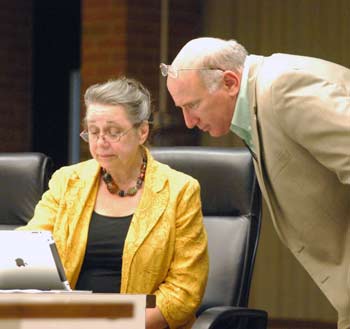
City councilmember and planning commissioner Sabra Briere and Eli Cooper, the city’s transportation program manager.
Cooper noted that a few years ago, the police did a targeted enforcement of the crosswalk ordinance in a couple of locations. Enforcement is intended to bring attention to the fact that there are rules, he said, and that the local government is enforcing those rules. There will always be people who say that more can be done, he added, and the staff continues to reflect on the city’s internal policies and processes, which includes outreach and communication, engineering and police enforcement. Enforcement takes resources, Cooper said, but he felt confident that in three or four years, the city would be able to say that enforcement has been stepped up.
Diane Giannola noted that in the past, someone had spoken to the commission during public commentary about the need to incorporate this update into the original 2007 plan, rather than have the update as a standalone document. She asked Cooper to address that issue.
Cooper responded to Giannola saying that when the update is adopted, each word will carry the same policy weight as the original plan – so in that sense, the documents are incorporated. About 60-70% of the 2007 plan remains valid, he said, and the update is meant to “freshen it up” with some new policy issues and recommendations. It’s more administratively efficient to use this approach, he said, noting that the update will cross-reference the original plan.
Westphal asked for Cooper’s insight into the use of the plan as it relates to bike parking for new developments. The city code requirements for bike parking are reviewed during the site plan process for new developments, Cooper noted, and that’s appropriate. The feedback he’s heard is that the city is doing a good job with new development, but there’s more concern about how existing developments can be retrofitted to provide more bicycle parking.
Outcome: Commissioners voted unanimously to add the non-motorized transportation plan update to the city’s master plan. The group also recommended that the city council take the same action.
Non-Motorized Transportation Update: Public Commentary
No one spoke at a public hearing on the plan update, held prior to the commission’s discussion and vote. However, during public commentary at the end of the meeting, Kathy Griswold addressed the commission. She said she’s been advocating for non-motorized transportation improvements and sidewalks for 20 years. Her first project was in the mid-1990s to push for constructing a sidewalk so that school children wouldn’t have to walk in the road along Penberton. It had been a simple process, she said. She’d gone to then-mayor Ingrid Sheldon, who talked to city staff and homeowners. The sidewalk was then constructed, Griswold said. “It hasn’t been that easy since then.”
Griswold said that city staff have been meeting with councilmembers from each ward, providing maps that show sidewalk gaps, although there are a few errors in the maps, she noted. Griswold said that until recently, she had served on the transportation safety committee for 15 years. There had been a process to identify sidewalks that were needed, she said. A member of the city’s engineering staff also serves on that committee, as well as staff from the public schools. However, the recommendations from that committee had been overruled by former city administrator Roger Fraser, she said. “Roger Fraser was not a supporter of sidewalks.” She reported that she had requested information under the state’s Freedom of Information Act and contended that she has more than 150 emails explaining why Fraser thought that no more sidewalks were needed in Ann Arbor.
In 2009, the transportation safety committee had recommended a sidewalk on Waldenwood. It has not been put in. A letter to current city administrator Steve Powers from Dave Comsa, the previous interim superintendent of Ann Arbor Public Schools, was written on July 23, 2013, asking that the city construct that sidewalk, Griswold said. A midblock crossing that’s used now requires a crossing guard at taxpayer expense, she noted. A new sidewalk would allow for a safer crossing at the nearby four-way stop. It’s despicable that the city isn’t committed to getting children to school safely when they walk, Griswold said, “and that needs to be done immediately.”
U-Haul Expansion
A proposed expansion to the U-Haul business at 3655 S. State St., south of the I-94 interchange, was on the planning commission’s Sept. 10 agenda. The project previously had been reviewed by commissioners on July 2, 2013, when they ultimately voted to postpone a vote so that the owner could address outstanding issues that had been raised by planning and engineering staff members.
The project calls for building a 1,246-square-foot addition to the front of the existing retail building. The expansion includes a new 4,994-square-foot, one-story warehouse and an 11,696-square-foot, one-story self-storage building. Both of the new buildings would be at the rear of the site and not visible from South State Street. The project is estimated to cost $1.2 million.
This site is part of the area covered in the South State Street corridor plan, which the planning commission had voted to add to the city’s master plan at its May 21, 2013 meeting. That plan calls for office uses at that U-Haul location in the future. The plan also recommends “enhanced non-motorized access to buildings, and aesthetic improvements recognizing State Street as a gateway corridor to the City,” according to the memo. The city council, which also is required to approve anything that’s added to the city’s master plan, had postponed action on the South State corridor plan at its July 1, 2013 meeting. That postponement came after Marcia Higgins said she had some concerns. The council subsequently approved the corridor plan on July 15, 2013.
On July 2, planning commissioners had spent about an hour raising concerns and asking questions about the U-Haul project. Many of the issues related to landscaping, site visibility, and how the site will look from South State Street after the changes are made.
On Sept. 10, Matt Kowalski of the city’s planning staff reviewed the changes that had been made since July 2, noting that the owner had responded to the issues that were raised. A pedestrian connection to South State was moved from the north side of the building to the south side, and landscaping was revised to comply with the city’s right-of-way landscaping buffer.

Computer-generated image of U-Haul property as seen from South State Street, with the proposed landscaping. (Image included in the planning commission’s meeting packet.)
At the request of commissioners, the owner provided a computer-generated image of how the property would look from South State Street, after the landscaping is in place.
There had been concerns about lighting, so the owner had provided a revised photometric plan that staff has reviewed and accepted, Kowalski reported. An interior lighting plan was also submitted.
No changes will be made to the permanent signs, Kowalski said, although he noted that temporary signs that were illegally in the right-of-way have been removed.
Otherwise, there were no significant changes to the proposal, Kowalski said. He added that a development agreement is included in the meeting packet, which hadn’t been completed at the July 2 meeting. [.pdf of development agreement]
Staff recommended approval of the plan.
U-Haul Expansion: Public Hearing
Samantha Keating, principal planner in the construction department of Amerco Real Estate Co. of Phoenix, Arizona, told commissioners that U-Haul has looked at all issues raised by the planning commission and had tried to address those. She said she was on hand to answer any further questions.
U-Haul Expansion: Commission Discussion
Sabra Briere asked if there was any marking or grade change to indicate where the crosswalk is.
Matt Kowalski replied that the current proposal calls for painting stripes on the asphalt to indicate the crosswalk’s location. If “sufficient” pedestrian use of that crosswalk is anticipated, Briere said, it would be desirable to have a “stronger visual cue” than paint, which wears off. “That’s just a future reference comment, I guess,” she said.
Bonnie Bona asked whether the sidewalk that runs along the building is barrier-free. Samantha Keating, who represented U-Haul, replied that the sidewalk is flush with the pavement.
Bona also noted that the July 2 discussion had included the “oddness” of having the building expansion jut out toward South State, closer to the driveway traffic. The addition has nothing around it to protect it, she said. “The whole thing still feels like it’s vulnerable.” People who aren’t accustomed to handling large vehicles will be going in and out of the driveway, she noted, so there’s potential to hit the building.
Keating indicated that the design team had looked carefully at the location of the building addition, and they don’t anticipate any problem. There have been no problems with people driving onto the current section of the land where the addition will be located.
Outcome: Commissioners unanimously recommended approval of this proposal. It will be forwarded to the city council for action. The project is also subject to approval by the Washtenaw County water resources commissioner.
Redevelopment Ready Communities Program
Following adjournment of the Sept. 10 regular meeting, planning commissioners relocated to city hall’s basement conference room for a 30-minute working session. The topic was a briefing on Michigan’s “Redevelopment Ready Communities” program, in which the city of Ann Arbor is participating. [.pdf of program overview]
Planning manager Wendy Rampson said that staff didn’t have the chance to consult with planning commissioners before applying to the new state program earlier this year. The application had been made on the heels of the city council and planning commission approving a new sustainability framework, she noted, and soon after the council had determined that economic development was a priority for the city. [.pdf of Ann Arbor application to the RRC]
The program was originally developed by the nonprofit Michigan Suburbs Alliance, she said, and later acquired by the state through the Michigan Economic Development Corp. [Both organizations have local connections. The suburbs alliance is led by Conan Smith, an Ann Arbor resident who also is an elected official serving on the Washtenaw County board of commissioners. MEDC's CEO is Michael Finney, former head of Ann Arbor SPARK.]
Rampson described the program as a tool to help communities put in place elements that would allow redevelopment to happen. Those things include master plans that are clear about what community expectations are for new developments, and zoning that reflects those expectations in a very specific way. It means that when developers look at a specific property, they’ll be able to know exactly what they can do. Processes are documented and streamlined, so a developer doesn’t get “hung up in areas where time is money,” she said.
The program includes a list of best practices focused on six categories: (1) community plans and public outreach; (2) zoning policy and regulations; (3) development review process; (4) education and training; (5) redevelopment ready sites; and (6) community prosperity (economic strategies, marketing and promotion). [.pdf of best practices document]
Regarding zoning policy and regulations, Rampson referred to the city’s ZORO (zoning ordinance reorganization) project, “if we can ever get it back on track. The idea of having ordinances that are easily understood is very, very important.”
The ZORO project, which started in 2009, is a comprehensive zoning code review aimed at streamlining the development-related city code, clarifying terminology, and eliminating inconsistencies and outdated material. It was last discussed in detail by planning commissioners at their April 23, 2013 retreat, when several commissioners expressed frustration that ZORO seemed to be languishing in the city attorney’s office. On Sept. 10, Rampson characterized the length of the project by noting that one of the city planners has had two children since ZORO was launched.
In March of 2013, the MEDC announced that 8 communities – including Ann Arbor – had been selected for the program’s first round to receive a formal Redevelopment Ready Communities evaluation. If the city completes this evaluation successfully, Rampson said, then it would be certified as a “Redevelopment Ready” community. The state has indicated that communities with this certification could receive priority points on grants from MEDC and the Michigan State Housing Development Authority (MSHDA). There isn’t a track record yet for what that really means, Rampson said, but staff felt it was worth pursuing.
Before the staff can proceed, Rampson explained, the city council must pass a resolution stating that the city can participate. On Oct. 14, the issue will be on the agenda for a joint city council and planning commission working session – although the main topics will be the current downtown zoning review and R4C/R2A zoning revisions.
Rampson said she and Sumedh Bahl, the city’s community services area administrator, attended the program’s first training session about a month ago on master planning, taught by Andrea Brown, executive director of the Michigan Association of Planning. Rampson offered to share the PowerPoint presentation with commissioners.
The MEDC is also pulling together planning tools that communities can use, even if they’re not getting certified, Rampson said. She highlighted a 30-page reference guide for techniques to solicit public participation, which the city of Ann Arbor plans to incorporate into its public processes.
As the city is evaluated, Rampson said she thinks Ann Arbor will get high scores for the accessibility of planning and development documents online. An area where the city might not score well is the clarity of its ordinances, she added – and that’s why the ZORO project is so important.
Rampson also noted that right now, even some relatively minor projects require city council approval. As an example, she cited the recent expansion of Allen Creek Preschool. Does that really need city council approval, just because the addition was more than 10% of the structure’s floor area? “Those are the types of discussions that I welcome, because the time that we’re not spending on unnecessary process can be used on other things.”
To receive certification, the city also has to show commitment to following up on recommendations from the program evaluation, Rampson said.
Redevelopment Ready Communities Program: Commission Discussion
Ken Clein asked if Rampson anticipated any opposition from city council to this program. It depends, Rampson replied. “I think people sometimes worry that by focusing on processes and improving opportunities for developers, that it throws open the door for developers to come in and do things that the community doesn’t want.” Coming fresh off the 413 E. Huron project, there might be some hesitation on the part of councilmembers, she said.
But in the context of the whole city and the corridor efforts, “I hope that people will see that there’s an overall benefit,” Rampson added. If the process isn’t working as the community wants, it should be fixed. But it shouldn’t be made onerous for everyone, simply because one project came through that people didn’t like.
Sabra Briere, who also serves on the city council, said one of the problems is the concept of “redevelopment ready.” For some people, she said, “that sounds like ‘Tear down all the old stuff.’” She indicated that it might mean there needs to be an educational process.
Briere also pointed to the goal of making it simpler for new developers to come in and know – in a predictable fashion – how they can take advantage of development opportunities. Although that predictability might be desirable in many situations, “for quite a significant portion of the population that deeply cares about not seeing Ann Arbor change, that [predictability] is just enabling more development than Ann Arbor can stand.” Every time there’s a change downtown or in a neighborhood, people get more polarized, she said.
Finally, Briere addressed the idea of whether the planning commission should be able to approve anything without it being decided by the city council. “For many people, council is the last line of defense, as it were,” she said. That attitude is true for some councilmembers as well as for the public, she added. The 30-day gap between a vote by the planning commission and a vote by the city council is a gap that “people embrace, if they’re objecting to a proposed development.”
These are issues that might cause some problems at the council, Briere said. “I’m just predicting – I have no idea how any one person would feel, but right now development’s a very sensitive subject. And for some people, no development is the goal.” There are even people who think the city is going in the wrong direction when it spends money and staff time on corridor improvement projects, she noted. Briere said she personally would want to plan for the future, and decide on a set of goals for development on any particular piece of property. “But I have observed that there are people who think we shouldn’t even try.”
Clein replied, saying it’s ironic that a lot of times the people who object to projects are “a real small, vocal minority.” For most people, he said, development doesn’t rise to be an issue that compels them to get involved. So this small vocal minority in some cases is directing development or non-development in this town, he said.
Briere responded that she would “never discount the possibility that while we may have a vocal group of people who want to give input, that they are only representing themselves and not the tip of the pyramid.” People rarely communicate with members of council, or come to planning commission, because they’re not passionately engaged at that moment. That doesn’t mean they don’t care, Briere said. As the city saw with 413 E. Huron, even a tree can become a passionate rallying point for a lot of people, she noted, who otherwise wouldn’t have thought to voice an opinion to the council or the planning commission.
Referring to a “vocal minority” implies that those voices aren’t as significant as the voices that aren’t being heard, she said. “All we know is that we’re not hearing those other voices – we don’t know why.”
Diane Giannola noted that you can’t assume the majority of people who aren’t expressing an opinion agree or disagree with the people who are more vocal.
Jeremy Peters pointed out that redevelopment inevitably will occur – because property will change hands. The access to grant funding to accomplish goals and community benefits that the city wants is important. That’s why participating in this Redevelopment Ready Communities program is important, he added, “irrespective of what the trademarked name was.”
Briere said there are some things in the program that are virtues to be working toward, like increased community participation, as well as clearer and better-organized ordinances. She thought those two areas should be the focus when presenting the program to the council.
Communications & Commentary
During the meeting there were several opportunities for communications from staff and commissioners, as well as two general public commentary times. Here are some highlights.
Communications & Commentary: D1 Zoning Review
Planning manager Wendy Rampson gave a brief update on the current slate of public forums held by consultants who are developing recommendations as part of a downtown zoning review. The consultants – Erin Perdu and Megan Masson-Minock – have put together a workbook for presenting at these forums. [.pdf of workbook] [.pdf of slides from forum presentations] The same information is part of an online survey that’s underway through Sept. 17. The intent, Rampson said, is to get as much feedback as possible before the consultants make their recommendations.

Consultant Megan Masson-Minock, far left, leads a public forum on Sept. 11 at Bill’s Beer Garden to get feedback on the ongoing downtown zoning review. Four people attended.
The work is the result of a city council resolution passed on April 1, 2013. It directed the planning commission to address three specific questions: (1) whether D1 zoning is appropriately located on the north side of Huron Street between Division and South State (the location of the 413 E. Huron project, Sloan Plaza and Campus Inn) and the south side of William Street between South Main and Fourth Avenue (where a parking lot and DTE offices are located); (2) whether the D1 residential FAR [floor area ratio] premiums effectively encourage a diverse downtown population; and (3) whether a parcel on the south side of Ann Street adjacent to city hall should be rezoned “to the appropriate zoning for this neighborhood.” That parcel, currently a surface parking lot, is now zoned D1, which allows for the highest density development.
The council’s resolution set a deadline of Oct. 1 for the planning commission to deliver recommendations to the council.
However, Rampson reported that the schedule has changed slightly. Sabra Briere, the city council’s representative on the planning commission, has informed the council that the work will take a couple of additional weeks to complete. The goal is to review the consultants’ report at an Oct. 8 planning commission working session, and then take action on those recommendations at the Oct. 15 regular meeting of the commission. At that point it will be transmitted to the council, she said.
A final public forum to review all of the feedback gathered so far will be held on Thursday, Sept. 19 starting at 7 p.m. at the Workantile, 118 S. Main.
For more background, see Chronicle coverage: “Priorities Emerge in Downtown Zoning Review” and ”Downtown Zoning Review Moves Forward.”
Communications & Commentary: R4C/R2A Advisory Committee
Bonnie Bona reported that the reconstituted R4C/R2A advisory committee had asked her to attend a Sept. 11 meeting to help them understand the planning commission’s discussions about the residential zoning revisions that were recommended to city council earlier this year. Bona said she’d do her best to represent the commission’s views, “but I will take full responsibility for everything I say.”
The Chronicle attended that meeting, which will be covered in a separate report. For additional background, see Chronicle coverage: “R4C/R2A Committee Focuses Its Work” and “Planning Commission Signs Off on R4C Draft.”
Communications & Commentary: Public Hearing
A public hearing is scheduled for the planning commission’s Sept 17 meeting on a rezoning request, site plan and wetland use permit for the proposed Traverwood Apartments at 2025 Traverwood. The plan calls for building 255 one- and two-bedroom apartments in 14 buildings, accessed by two new driveways from Traverwood Drive.
Communications & Commentary: Michigan Association of Planning Conference
Wendy Rampson reported that six people – staff and two commissioners – will be attending the Michigan Association of Planning annual conference on Oct. 2-4 in Kalamazoo. [.pdf of conference schedule] She plans to bring a resolution to the Sept. 17 meeting to authorize the attendance of the two planning commissioners, Paras Parekh and Sabra Briere.
By way of additional background, two city of Ann Arbor staff – Matt Naud, the city’s environmental coordinator, and Jamie Kidwell, who worked on the city’s sustainability framework – will be panelists at one of the sessions on Thursday, Oct. 3. The session is titled “Michigan Green Communities: Increasing Innovation through Peer Learning”
Present: Bonnie Bona, Sabra Briere, Ken Clein, Diane Giannola, Jeremy Peters, Kirk Westphal, Wendy Woods, Paras Parekh. Also: City planning manager Wendy Rampson.
Absent: Eleanore Adenekan.
Next regular meeting: Tuesday, Sept. 17, 2013 at 7 p.m. in the second-floor council chambers at city hall, 301 E. Huron St., Ann Arbor. [Check Chronicle event listings to confirm date]
The Chronicle survives in part through regular voluntary subscriptions to support our coverage of publicly-funded entities like the city’s planning commission. If you’re already supporting The Chronicle, please encourage your friends, neighbors and coworkers to do the same. Click this link for details: Subscribe to The Chronicle.






